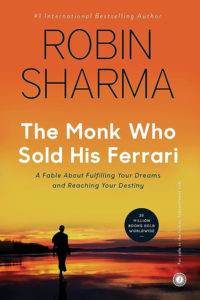 “The Monk Who Sold His Ferrari” is a self-help book written by Robin Sharma. The book is presented as a fable and offers advice on confronting personal and professional challenges, living life to the fullest, and finding inner happiness. Here I have the full summary of this book.
“The Monk Who Sold His Ferrari” is a self-help book written by Robin Sharma. The book is presented as a fable and offers advice on confronting personal and professional challenges, living life to the fullest, and finding inner happiness. Here I have the full summary of this book.
Comprehensive Summary of “The Monk Who Sold His Ferrari”
Introduction: A Life Transformed
Julian Mantle, a successful but unfulfilled lawyer, experiences a heart attack in a packed courtroom. This life-threatening event prompts him to seek a life of greater purpose. Selling all his possessions, including his prized Ferrari, Julian embarks on a spiritual journey to the Himalayan mountains.
The Wisdom of the Sages
In the Himalayas, Julian encounters a group of sages who impart to him their ancient wisdom about life and success. Julian learns that a balanced life is the key to true success and happiness. The sages introduce Julian to a series of rituals and practices that promise to transform his life.
 The Ritual of Solitude
The Ritual of Solitude
The importance of spending time alone is emphasized. Solitude allows for self-reflection, which is essential for personal growth. By regularly seeking moments of solitude, one can gain clarity about their life’s purpose and direction.
The Ritual of Physicality
Physical health is intrinsically linked to mental and spiritual well-being. Regular exercise, yoga, and other physical activities are crucial for maintaining a healthy body and mind. The sages stress the importance of treating one’s body like a temple.
The Ritual of Live Nourishment
Diet plays a significant role in one’s overall well-being. Consuming natural, fresh, and unprocessed foods nourishes both the body and the mind. Julian learns the importance of mindful eating and the benefits of a plant-based diet.
The Ritual of Abundant Knowledge
Continuous learning and personal growth are emphasized. Reading, seeking new experiences, and being curious about the world can expand one’s horizons and contribute to a fulfilling life.
The Ritual of Personal Reflection
Reflecting on one’s actions, decisions, and experiences is essential for personal growth. By understanding past mistakes and successes, one can make better decisions in the future.
The Ritual of Early Awakening
Rising early offers a peaceful start to the day, allowing for meditation, planning, and setting a positive tone for the day ahead. The early morning hours are seen as a sacred time for personal growth.
The Ritual of Music
Music has the power to uplift the spirit, heal wounds, and inspire. Incorporating music into daily life can provide emotional and spiritual nourishment.
The Ritual of the Spoken Word
Affirmations and positive self-talk can shape one’s mindset and reality. Speaking words of encouragement and positivity can manifest one’s desires and goals.
The Ritual of Congruent Character
Living in alignment with one’s values and beliefs is crucial for a life of integrity. Actions should reflect one’s inner beliefs, leading to a life of authenticity.
The Ritual of Simplicity
In a world filled with distractions, simplifying one’s life can lead to greater focus and fulfillment. Prioritizing what truly matters and letting go of unnecessary burdens can lead to a more meaningful life.
Conclusion: A Return to the World
After his transformative journey, Julian returns to the modern world, eager to share the wisdom he’s gained with others. He meets with his former colleague, John, and recounts his experiences, hoping to inspire John and others to seek a life of greater purpose and fulfillment.
This summary captures the essence of Robin Sharma’s “The Monk Who Sold His Ferrari,” emphasizing the rituals and lessons Julian learns during his spiritual journey.
Backdrop of Creation
“The Monk Who Sold His Ferrari” was written during a time when Western society was experiencing a surge in interest in Eastern spirituality and self-help. The 1990s saw a boom in self-help literature, with many seeking alternative paths to happiness and fulfillment beyond material success. Sharma’s personal journey, including his shift from a litigation lawyer to a self-help author and leadership expert, mirrors Julian’s transformation in the book. This personal transformation and the broader societal context influenced the creation of this novel.
Sharma’s Literary Landscape
Robin Sharma has written numerous books focusing on leadership, personal growth, and self-discovery. While “The Monk Who Sold His Ferrari” is a fable, other works like “The Leader Who Had No Title” and “The 5 AM Club” also emphasize self-improvement and leadership but through different narrative styles. Sharma’s consistent theme is the idea that anyone can achieve greatness and inner peace through deliberate practice and self-reflection.
Public Reception
Upon its release, “The Monk Who Sold His Ferrari” was well-received, especially among readers seeking spiritual and personal guidance. Its simple storytelling combined with profound life lessons made it accessible to a broad audience. Over time, while many have praised its wisdom and practical advice, some critics have pointed out its simplicity and the lack of depth in certain areas. However, its continued popularity indicates its lasting impact in the self-help genre.
Comparative Literary Analysis
During the time of its publication, the self-help genre was flourishing with authors like Stephen Covey’s “7 Habits of Highly Effective People” and Dale Carnegie’s works gaining traction. Sharma’s book, with its blend of Eastern spirituality and Western narrative, offered a unique perspective. While Covey and Carnegie focused more on practical habits and interpersonal skills, Sharma delved deeper into inner transformation and spiritual awakening. The fable format of “The Monk Who Sold His Ferrari” also set it apart, making its teachings memorable through storytelling.
What do you think about this book? Let me know in the comments!

Comments